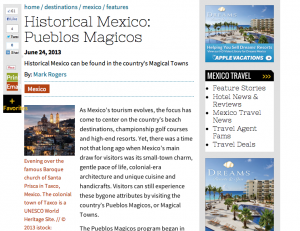travelagewest.com

Historical Mexico: Pueblos Magicos
As Mexico’s tourism evolves, the focus has come to center on the country’s beach destinations, championship golf courses and high-end resorts. Yet, there was a time not that long ago when Mexico’s main draw for visitors was its small-town charm, gentle pace of life, colonial-era architecture and unique cuisine and handicrafts. Visitors can still experience these bygone attributes by visiting the country’s Pueblos Magicos, or Magical Towns.
The Pueblos Magicos program began in 2001. To date, there are 83 towns in all 31 states that have been designated Pueblos Magicos by Mexico’s Ministry of Tourism. To become a Magical Town there are the obvious requirements — the towns need to have historical importance, unique cultural traditions and natural beauty. The towns also need to have a population of at least 20,000 residents and be located within about a two-hour drive from a major tourist destination. A major appeal for many of the Pueblos Magicos will be as a day-trip from a larger city or resort area.
Once a town is chosen, it undergoes a process of careful modernization of its infrastructure and tourism-related businesses to increase its ability to welcome tourists. There have been instances of towns being removed from the list for not maintaining the necessary standards; for example, Tepoztlan, in Morelos, was removed and eventually reinstated. There has also been an instance of a town becoming too mainstream to remain a Pueblos Magicos, such as San Miguel de Allende, when it was designated a UNESCO World Heritage Site in 2008.
Some of the Magic Towns will be familiar to travelers, such as Taxco and Todos Santos. Others are likely to be relatively obscure, such as Creel, a logging town in Chihuahua, and Real de Catorce, in San Luis Potosi, a silver mining town with a spiritual heritage encompassing the Catholic religion and shamanic practices of the indigenous Huichol people.
Accessing the Magic
While Pueblos Magicos may be off the beaten track, that doesn’t mean your clients have to settle for substandard conditions. Since these towns are chosen for their cultural heritage and beauty, creative entrepreneurs have opened sophisticated hotels and restaurants — many of which are in restored historic structures. Hotels tend to be boutique properties that blend in perfectly with the town.
The company Mexico Boutique Hotels was established well before the Pueblos Magicos program, although the synergy between the two belies that fact. Pueblos Magicos and Mexico Boutique Hotels are a great match, since they share a similar charter of celebrating the art, cuisine and folkloric traditions of Mexico in often out-of-the-way destinations within the country.
“There are actually more Pueblos Magicos than we can match,” said Sylvie Laitre, director general of Mexico Boutique Hotels. “There are visitors to the Caribbean who will choose to experience a different island on each trip. They may visit Jamaica one year, but instead of repeating the experience, they visit St. Lucia next year, for the first time. There’s a similar type of traveler who collects Pueblos Magicos and our boutique hotels. They have experienced one or more, and they want to expand their experiences rather than repeat them.”
In addition, Laitre mentioned what she referred to as “circuit business,” in which clients plan a route that includes overnights in several Pueblos Magicos. Most commonly, when a client settles on two destinations, they generally combine a beach and a city; when they choose three destinations, the itinerary often includes three cities within easy reach of each other via car.
Laitre has some basic advice for those considering a self-drive vacation visiting several Pueblos Magicos.
“First of all, if driving in Mexico is out of your comfort zone, there are a variety of options,” noted Laitre. “Besides bus service, which is of higher quality than my native Canada, it is really easy and cheap to hire a driver. Our hotels can make those arrangements, including bilingual drivers who also function as an informal tour guide. Hiring a driver is definitely worth the investment. If your clients decide to drive themselves, it’s helpful if one of them speaks Spanish. I also advise that they limit their driving to the daylight hours.”
Laitre provided a snapshot of the type of traveler who would be a good match for a visit to a Pueblos Magicos.
“It should be someone who has traveled a bit. They are people who want an authentic experience. They’re interested in the art and cuisine of a destination.”
Carlos Berdegue, president and CEO of El Cid Resorts and vice president of the Mazatlan Hotel Association, has some tips for Mazatlan visitors who are intent on expanding the scope of their vacation with a visit to the nearby Pueblos Magicos towns of Cosala and Rosario.
“I recommend that visitors use the services of one of the guides certified by the Mazatlan Historical Association,” said Berdegue. “It’s easy to make these arrangements through the hotel desk. While roads are easy to navigate, it’s a fact that visitors are in another country, so it’s best to use a guide.”
If visitors prefer to visit a Pueblos Magicos on their own, Berdegue recommends they rent a vehicle from a reputable car rental company.
“In Mazatlan, we have major companies, such as Hertz, Budget and Avis,” said Berdegue. “Visitors should also obtain a good map and tell their concierge the route they are taking on their day-trip. That way, if the couple happens to experience a flat tire or something, the concierge knows where they are.”
Getting to most Pueblos Magicos takes advance planning, since they are not usually located near an international airport. The town of Alamos is a good example of a Pueblos Magicos that takes extra effort to get to. I visited Alamos last year when I was in the state of Sinaloa for a family wedding. My wife and I arranged to stay a few nights at a Mexico Boutique Hotels property, Hacienda de los Santos, and we set off on the 3½-hour drive to Alamos from Ciudad Obregon. It was a pleasant journey through a largely rural landscape. Once in a while we would pass through a small town where farmers sold fresh corn along the roadside.
When we came to the entrance to Alamos — a huge arch over the road — it was like passing through a time portal to colonial Mexico. The large park-like square was surrounded by simple shops and trendy boutiques, and one side of the square contained a handful of open-air restaurants selling fish tacos and machaca (beef) burritos. The streets were narrow and many were cobblestone. The architectural centerpiece of the town is a dramatic 250-year-old Baroque church. I have spent some time in Catalonia in Spain, and Alamos brought back memories of the Spanish city of Girona. Hacienda de los Santos turned out to be an amazing property with one of the best art collections and gardens I have ever seen in a hotel. It was a great pick for a romantic getaway. And, while Alamos may be a poor choice for the mass-market tourist, it’s a perfect match for a traveler interested in experiencing authentic Mexico.
One of the more recent additions to the Pueblos Magicos designation is the Baja California town of Tecate, which has the distinction of being a Pueblos Magicos town close to the San Diego border crossing, making it reachable via a self-drive trip from the U.S.
Tecate is also the northeastern gateway to Baja’s wine country, which some hope may rival areas in California. Tecate’s Mount Kuchumaa and Serpent Mountain are sacred to the pre-Hispanic Kumiai people, and the nearby El Vallecito archeological site has cave paintings dating back 1,500 years. Tecate has comfortable ranch-style accommodations, including the award-wining spa property, Rancho La Puerta. In case you’re wondering, Tecate is also the home brewery for one of Mexico’s most famous beers.
While it’s true that many of the Pueblos Magicos are in far-flung corners of Mexico, there are a handful of towns that are within hailing distance of major resort destinations. The town of Todos Santos is only a 1½-hour drive from Los Cabos. Similarly, vacationers in Mazatlan can easily visit the Pueblos Magicos town of Rosario, a mining town with one of the most beautiful church altars in Mexico. Visitors enjoying Cancun or the Riviera Maya can arrange a trip to the town of Bacalar, a Mayan town that contains a 17th-century fort that saw battle against marauding pirates.
Certainly, Mexico’s sun and sand resorts are a major draw for tourists, but for those interested in another side of the country, being the first of their friends to discover one of the charming Pueblos Magicos will give them bragging rights back home.

